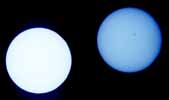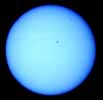| Merkurdurchgang
am 7. Mai 2003
Transit of Mercury 2003 May 7th |
 |
| Merkurdurchgang
am 7. Mai 2003
Transit of Mercury 2003 May 7th |
 |
We tried to participate in the project by Prof. Udo Backhaus of the university Essen.
The photos were taken with a Maksutov
1000/1:11 russian photo objective with a Baader solar screen
and the UV filter delivered with the objective.
The film was a Kodachrome 100,
exposure times 1/1000 and 1/500 sec.
The camera body was a Minolta X-700.
Unfortunately we had problems with the film transport (better: not-transport)
to get the double exposure. For reasons that are not yet totally clear,
this did not work always! Therefore we have also difficulties in identifying
which exposures relate to which exposure times. Some times were also forgotten
...
Observing place: Klagenfurt/Austria, lat=46°36'21.7", lon=14°15'22.2" (GPS, WGS84 position)
Observing place: Katschberghöhe/Austria, lat=47°03'35.1", lon=13°36'54.8" (GPS, WGS84 position)
| exposure number | time (MESZ)/ exposure time |
|
| 16 | 10:58:00 / 1/500s | |
| 17 | 11:00:00 / 1/500s |
 |
| 18 | 11:03:00 / 1/1000s |
|
| 19 | 11:05:00 / 1/1000s |
 |